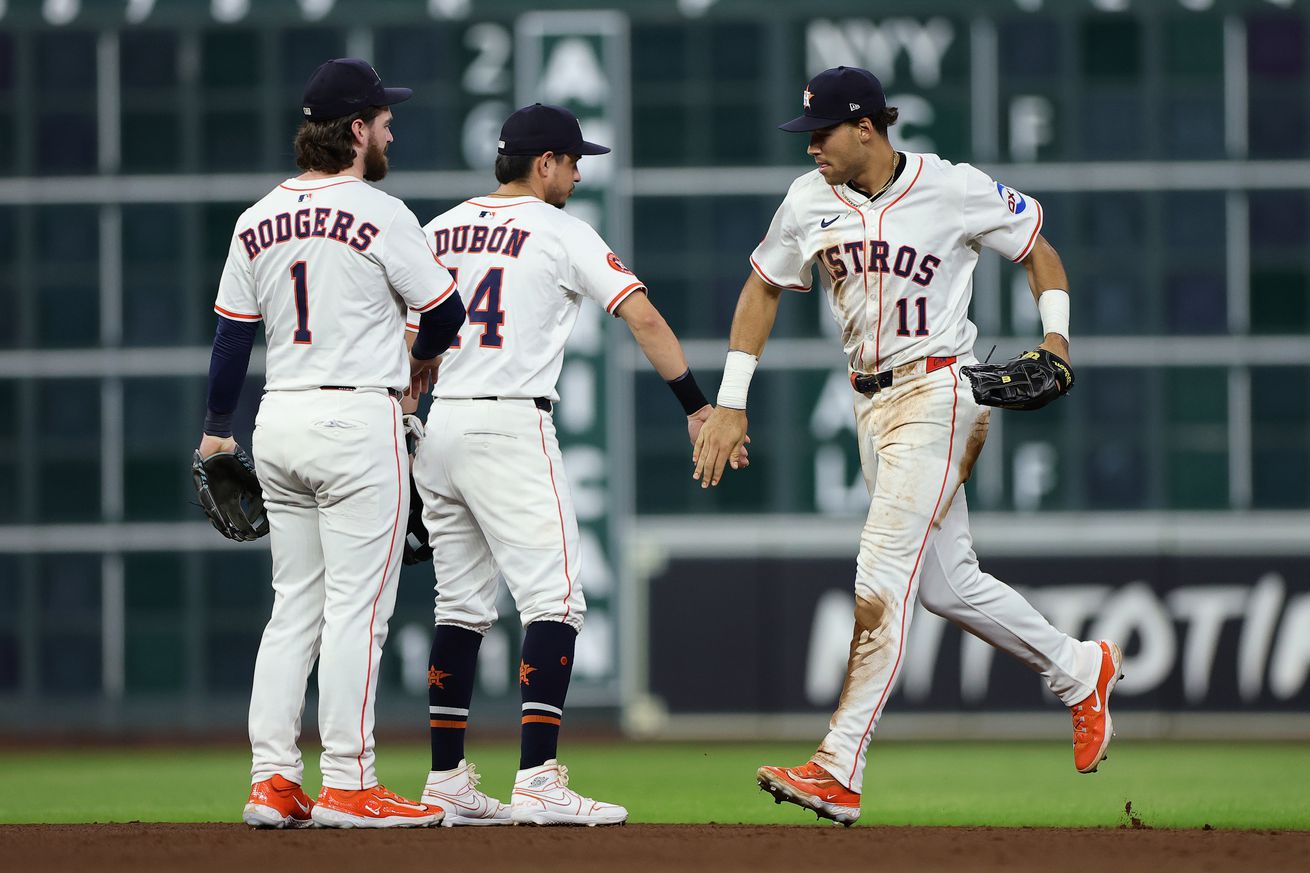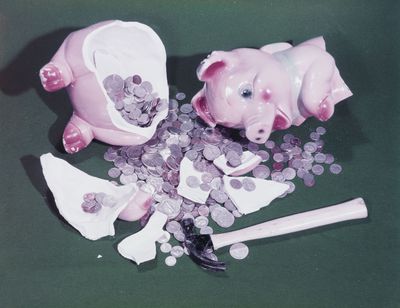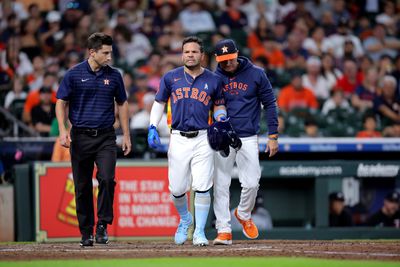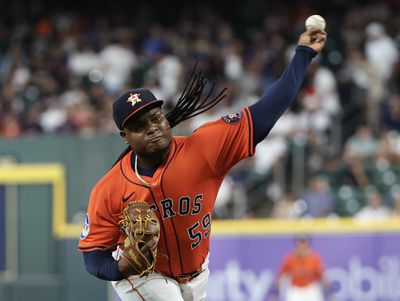
That question is more complex this year than in past seasons.
As the calendar moves ever closer to summer, MLB teams now know who they are and aren’t. Even with the expanded playoffs, teams will know if they have a legitimate shot at the playoffs or not. For the Houston Astros, after yet another trademark slow start (6 straight years starting the season 7-9 or worse), they find themselves back atop the AL West in mid-June. As they go for their 8th straight full-season division title and 9th straight post-season berth, they likely enter the summer trade season looking to add to the roster.
For a division-leader, Houston does not lack for areas of needed reinforcement. The team could use a left-handed power bat along with starting pitching and perhaps some bullpen help. Yet, Houston finds themselves in a difficult buying position. The once-loaded farm system now sits at the bottom of the MLB rankings, lacking the high-ceiling prospects that Houston could ship out for main roster upgrades. There are a few options on the main roster for trades (looking at you, Chas McCormick), but how much does Houston weaken its depth?
Then there is the biggest hinderance to Houston’s deadline moves: the CBT line. While Houston hasn’t explicitly stated as such, it is hard not to read the off-season moves of the Astros, from the Tucker and Pressly trades, to letting Bregman and Verlander walk, to not getting extensions done with Valdez and not assess that Houston, having paid tax penalties for last season’s expensive roster, wants to avoid a repeater penalty. As the roster stands, and depending on the source consulted, Houston sits between $2-$5M under the first projected CBT line. If Houston wants to maintain that red line, there aren’t a lot of great 2025 options.
What does Houston do? Last year, the team already started the season way above the CBT line, so its big prospect package of a rental of Kikuchi, while painful to the farm system, didn’t change that much for Houston. At that point, “in for a penny, in for a dollar” applied, especially with that season having a “Last Ride” vibe. Now? With avoiding the CBT line a major organizational goal, what can Houston do?

Photo by Lambert/Getty Images
Break the CBT barrier: This move would upend the strategy of the 2025 Astros’ front office in so many ways. While the Tucker trade yielded 3 major leaguers who’ve made meaningful contributions to the roster (Wesneski did before he went down with season-ending surgery), Tucker got shipped out mainly due to the pending price tag for his services. While Pressly was slipping from his time as a World Series closer, his trade was a MLB version of a salary dump. Those moves got the team under the CBT. Not that Crane is afraid of going big if it is a calculated move to help the team, but is this team really one worth all of the repeater penalties (30% tax, loss of bonus pool and draft picks)? While the MLB playoffs are a crapshoot, if Houston is not a real contender, then why would Crane break the tax line, when he could use next season, with all of the resets, and reinforce the roster then? Are there those couple of players that are worth getting the repeater penalties and also weakening an already diminished farm system? That is a question Brown and Crane will need to answer before August.

Erik Williams-Imagn Images
Playing with its current roster: If the first CBT threshold is the solid red line for the team, perhaps Houston might just rely on what it has on-hand and takes its chances with the second half of the season. At present, the team seems to be able to win even with a ton of injuries and the various roster problems. The AL West does not appear all that formidable, so it won’t take much to win the division. Once in the playoffs, all bets are off. For pitching, there is the wild card of arms like Garcia, France and Javier. True, Garcia’s rehab has gone poorly with a lot of setbacks and awkward questions for the medical staff. However, the Astros’ braintrust, seeing that McCullers has at least returned to give the team varying quality of innings, might think that it can work out with the return of those other arms.
With the return of Alvarez and time to get him back in gear, the offense might finally get back to its potential. If Walker can get his bat going, along with Alvarez, Diaz, Altuve and Peña, Houston could enter the postseason with some playoff-dangerous offense. Additionally, the farm-based reinforcements (when healthy), might provide enough depth to help the squad weather the regular season grind. The squad’s overall pitching still rates among the best in the league, and good pitching, with timely hitting, can take you far in the playoffs. Granted, more injuries could wreck the lineup, and the Astros end up on the road to nowhere. However, Houston might be ok playing a longer game, as all the penalties reset if Houston stays under the CBT, for future benefit at the expense of any short-term changes for 2025.

Thomas Shea-Imagn Images
Win by Selling: For the past decade, the trade deadline is one where Houston is the buyer, but with the tax line considerations and the team’s overall position, what if the squad decided to sell? This would not be a full-on fire sale. Financial considerations or not, Crane will not entertain the early 2010s slash-and-burn of the roster. “The [contending] window will always remain open”, right? Yet, the Tucker trade offers a potential blueprint for Houston. Paredes and Smith offer Houston solid main-roster play, as Paredes led the team in homers before his hamstring injury and Smith continues to evolve into a MLB regular. The Tucker trade proved a financial and roster win. Could Houston try for another repeat?
For this to work, it likely would involve Framber Valdez. Granted, this would seem to be a strange/stupid move for contender. Trade a co-ace in the middle of a playoff chase? After a sluggish start to the season, Valdez is back to, Cy Young-caliber Valdez, which, along with Brown, gives Houston arguably the best 1-2 punch in MLB. Yet, Valdez in his walk year. To date, the team hasn’t offered any extension to Valdez. Given last season’s market for starters, and Houston aversion to handing out big multi-year contracts like what Burnes and Fried received, Valdez likely starts 2026 in another uniform. If Valdez walks in the offseason, Houston only receives a mere compensatory draft pick after the obligatory declination of the qualifying offer.
True, if Houston wanted to maximize the trade return, it should have dealt Valdez in the offseason. Yet, desperation can increase return value, and many teams are desperate for an ace like Valdez. This would put more pressure on Brown to deliver and for the rest of the rotation to step up. However, the team might shave more salary off its books (Valdez has an $18M salary for 2025), and have some building blocks for the near-term future. If a package of Valdez and McCormick could bring back a quality starter and a solid lefty bat, along with a prospect or two, Houston might actually execute that deal.
Does this author expect the team to trade Valdez? No, but it can’t be completely discounted either. While Houston will likely add to the roster, its trade deadline actions, for the first time in years, are not as certain. There are cases for doing nothing or actually selling, and those moves fit in line with current Houston actions. Could the team surprise and either go all-in, or suffer a horrific early July slump and punt on 2025 to set up for ‘26 and beyond? Sure. However, the 2025 deadline for Houston will be interesting, not for who Houston brings in, but just what will the organization actually do.